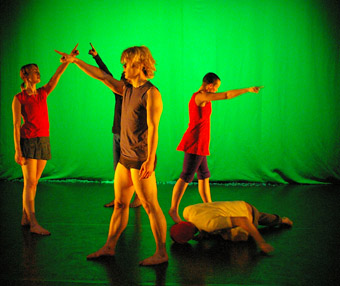The body in the world
Sue Moss at TasDance’s 25th birthday
 Tanja Liedtke's Always Building
Tanja Liedtke's Always Building
front: Jason Lam, left to right: Tanya Voges, Kyle Kremerskothen,
Trisha Dunn, Joshua Thomson
Established in 1981 as Australia’s first dance-in-education company, TasDance has over the past 25 years broadened its role to include theatre-based performance, dance development and dance in community, in the process earning a national reputation for innovation and its repertoire of contemporary Australian work.
Earth is a given beneath any dancer’s feet, regardless of nationality, training or stylistic imperative. Tasdance’s anniversary program, The Earth beneath our feet, features works by 3 choreographers: As the Crow Flies by Nanette Hassall, Always Building by Tanja Liedtke and A Volume Problem by Byron Perry. These pieces offer diverse perspectives on the connections between earth, space, place and the body.
Hassall’s As the Crow Flies is a seminal work from 1988. Using cartography as a starting point, the choreographer explores perspectives of the earth viewed through satellite imaging juxtaposed against the mind’s internal landscape. The dancers engage in a complex physical cartography through hold, lift, fall and counterbalance. The shifting pattern of the dancers’ bodies corporeally represents the images of a satellite earthscape shaped by sand, wind and tide.
The dance is set to Shaker Loops by John Adams. A distinctive feature of the performance and a mark of each dancer’s finesse is the impetus from a push, touch or gesture initiating a new movement sequence. This pattern of devised solos, duos and trios depicts a variety of avian and human perspectives and inter-relationships within a landscape. The trio dance is particularly fluid and sensual, complemented by controlled strength and power. There is little time for the eye to linger as the dancers confidently grapple with the demands of Hassall’s choreography.
Always Building is a work that addresses construction and destruction. Choreographer Tanya Liedtke uses Lego pieces as a visual metaphor to portray aspects of building—a constant cycle of destruction and renewal of individuals, cities and civilisations. Audience members are invited to join 5 dancers each seated at a table. The tables represent the temporal nature of the substrate on which different buildings are already constructed. Each volunteer helps assemble blocks of a particular colour to continue the building. When the completed structures are tipped and the tables are used to sweep pieces to the rear of the stage, we hear a resonance of collapsed and shuffled plastic. Dancers segue into corporeal building blocks, falling, rising, creating and destroying. Lego pieces are used to demarcate the individual, group and society.
One dancer personifies ennui. Working as a controller she listlessly points an arrow to direct the pattern of movement. The Lego blocks remain the constant connector, a metaphor for the continuous cycles of structural and emotional exchange involving patterns of encroachment, construction and collapse.
A Volume Problem is choreographed by Byron Perry in collaboration with the dancers. Lit by a single spot, 2 speakers glimmer like the eyes of a shining temple god resting on a grassed earth cube. In a mesmerising opening sequence 6 dancers move their fingers across, over and around the plinth, animating the speakers.
A static charge from the speakers animates the dancers who p(l)ay homage to the sound source. In a strange inversion it seems that the speakers are dancing the dancers who move in sculptural clusters of twos and threes, emanating a strange beauty. This iconography of speakers, with their ear-phoned, switched on, jacked in sound worlds, assumes life and power. This is a familiar world bent into the unfamiliar. It is riveting viewing.
Luke Smiles’ sound design is an ordering of noise into sense. This accentuates the dancers’ exploration of the speakers’ allure. In response to the static charge and each speaker’s strange potency, the dancers portray the shifts and connections of attraction. Their fascination gives way to separation and isolation as each moves into the lonelier place of recollection and memory.
In the final sequence Darren Willmott’s lighting design accentuates larger than life shadows as the dancers crowd onto the grassed cube. With feet anchored and backs turned to the audience, the group responds with a surreal energy. In one segment only 2 remain on the cube, revealing the possibility and contradiction inherent in patterns of volume and noise. One dancer responds with total passivity, the other with frenetic movement. A Volume Problem is a quirky work of elusive familiarity.
TasDance, The Earth beneath our feet, dancers Floeur Alder, Trisha Dunn, Kyle Kremerskothen, Jason Lam, Joshua Thomson, Tanya Voges; As the Crow Flies, choreography Nanette Hassall, lighting Darren Willmott; Always Building, choreography Tanja Liedtke with dancers, composer Jason Sweeney, set & lighting Ben Cobham, Bluebottle; A Volume Problem, choreography Byron Perry, sound Luke Smiles, Motion Laboratories, lighting Darren Willmott, design Anita Holloway, costumes Alice Richardson, Odette Arrieta-Shadbolt; Collegiate Performing Arts Centre, Hobart, June 29-July 1
RealTime issue #74 Aug-Sept 2006 pg. 35






